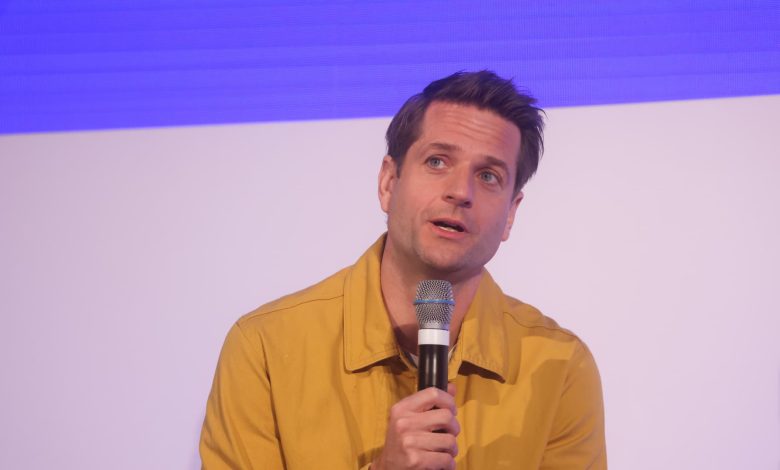Klarna CEO outlines plan to become super app with AI

Sebastian Siemiatkowski, CEO of Klarna, speaking at a fintech event in London on Monday, April 4, 2022.
Chris Ratcliffe | Bloomberg via Getty Images
Klarna’s CEO is so bullish about artificial intelligence that he sees it changing the way the fintech’s 100 million users bank every day.
On Wednesday, Klarna — a pioneer of the popular “buy now, pay later” (BNPL) payment method — is announcing the launch of mobile phone plans in the U.S. via a partnership with telecom services startup Gigs. The move follows in the footsteps of rival fintechs Revolut and N26, which have launched similar offerings. Klarna’s plans come with unlimited data, calls and texts and will cost $40 a month.
The new telco offering aligns with CEO Sebastian Siemiatkowski’s vision to make Klarna more of an all-encompassing personalized financial “super app” that can offer services outside the realms of traditional finance.
It isn’t the company’s first attempt. Previously, Klarna tried to make itself more akin to a “super app” — similar to Ant Group’s Alipay and Tencent’s WeChat Pay — offering additional services through multiple different buttons. This ended up being “confusing for the customer,” however, Siemiatkowski told CNBC in an interview.
But the Klarna boss stressed the part AI can play as looks to diversify its services and become known for more than its BNPL offering.
“I think in this new AI world, there’s a better opportunity to serve customers with different services and then adopt the kind of level of articulation and visualization of those services than there was historically,” Siemiatkowski said.
“With AI, you can abstract and adopt the experience much more to the specific user you’re dealing with,” he added.
Super apps are popular in China and in other parts of Asia. They’re meant to serve as a one-stop shop for all your mobile needs — for example, having taxi-hailing and food ordering in the same place as payment and messaging services.
However, while super apps have flourished in Asia, adoption in Western markets has nonetheless been slower due to a number of reasons.
‘Tremendous opportunity’
Siemiatkowski says he’s spending a lot of his time focusing on AI.
“There’s a tremendous opportunity for that — but it’s just getting it to work,” he said. “Everyone who has used it knows it can spit out some exciting stuff but then you need to make sure that it works every time.”
Going forward, Klarna’s chief sees the platform becoming more of a “digital financial assistant” for users’ every-day banking needs.
“If we have some information that suggests that you are overpaying for your carrier subscription or your data or whatever,” Siemiatkowski says, Klarna will aim to use AI to “offer you both a suggestion of a better price model, but also with a click, implement that and make it a reality.”
Acknowledging issues with Klarna’s previous attempt to become a super app, Siemiatkowski says the technology just wasn’t “mature” enough at the time.
Perception problem
Still, Klarna has a perception problem to overcome. In the U.S., the firm has become synonymous with the “buy now, pay later” (BNPL) payment method, which allows consumers to pay off orders over monthly installments — typically interest-free.
By contrast, European consumers recognize they can use Klarna to store their deposits and pay for things in one go as well as via a credit plan, according to Siemiatkowski.
He also expressed frustration with “the kind of memes that we get in in the U.S. when it’s like, ‘Oh, Klarna launched with DoorDash … it is a sign of the macroeconomic environment,” referring to a tie-up the company announced with food delivery app DoorDash earlier this year that was met with backlash online.
Siemiakowski said this kind of reaction wouldn’t happen in the German or Nordic markets, where Klarna operates more like online payment system PayPal.
He sees a future where Klarna works as a more all-encompassing financial ecosystem with add-on services such as features for investments in stocks and cryptocurrencies — which, he adds, is “not that far off.”
“Offering people the ability to invest in both stock and crypto is is what’s becoming a kind of more standard part of a neobank offering,” he said, while stressing he doesn’t want to compete with popular U.S. stock trading app Robinhood.
When will Klarna IPO?
Siemiatkowski said that Klarna has already achieved what it set out to do in order to be ready for that milestone — namely, building up a brand in the U.S.
“The U.S. is now our largest market by number of users. It’s a profitable market for us,” he said. “Those things have been accomplished.”
Whether the company does or doesn’t go public, the business strategy for Klarna remains the same.
“That is just a healthy way to drive liquidity for our shareholders, as well as give the company more ways to fund itself, if it would like to do so, and … to show that this is a an established company,” Siemiatkowski said.
WATCH: Why the U.S. doesn’t have ‘super apps’



